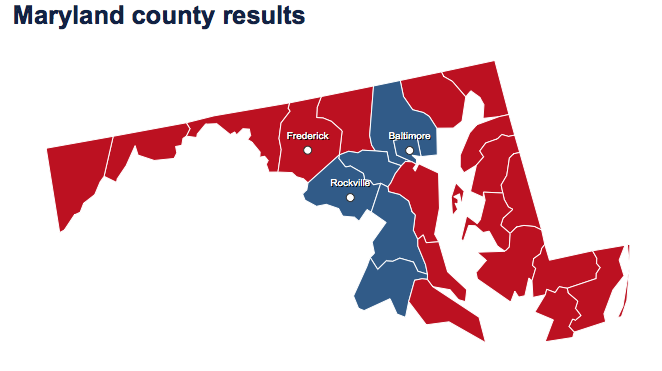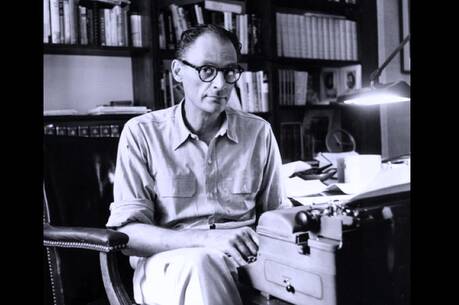Democratic dominance in Maryland comes from five counties running through the middle of the state, connecting the Baltimore and Washington, D.C. areas. But while the western panhandle and Eastern Shore are almost irrelevant in presidential elections, they occasionally get their way in off-years.
(Un)Conventional Wisdom is presenting a short history of each state’s role in modern presidential politics. Maryland is the seventh in the series.
Maryland was a swing state in the mid 20th century, straddling the North and South, but it’s been part of the Democratic base for more than five decades. In 2000, this was one of the few states where Al Gore ran ahead of Bill Clinton’s 1996 showing (up 2.4 points to 56.6 percent), and Barack Obama’s 62.0 percent in 2012 was the best showing by any candidate since presidential candidate since Democrat Lyndon Johnson in 1964.
So it wasn’t surprising when Gallup named Maryland as the most Democratic state earlier this year, with 54 percent of poll respondents identifying with the party (versus 32 percent claiming to be Republicans and the rest opting for independent status). Many constituencies that lean Democratic—including urban dwellers, college graduates, African-Americans, and public-sector workers—are more common in Maryland than in the rest of the U.S., and Barack Obama has been an especially effective party leader here. (He beat Hillary Clinton here by 25 points in the 2008 Democratic primary.)
What makes Maryland distinct from other suburb-dominated states in the Northeast (like Connecticut and New Jersey) is its large African-American vote and the presence of a large black middle class. Prince George’s County, which borders Washington, D.C., and accounted for 14 percent of all of Maryland’s votes in the 2012 presidential election, is the wealthiest majority-black county in America, with a median household income of $74,000—almost exactly the same as the median household income for the U.S. as a whole. Middle-class status has not transferred to middle-of-the-road politics, however. Obama got 90 percent of the vote in Prince George’s County (which is 65 percent black) in 2012, better than any presidential nominee as far back as county results are available. The Democratic margin of 312,000 from Prince George’s County was almost half of Obama’s margin of 706,000 in the entire state. (Obama’s 71 percent in mostly white, very highly educated, and much wealthier Montgomery County just pushed him into landslide territory.)
The Democratic strength in Prince George’s County is undoubtedly linked to the party’s identification with civil rights. But middle-class black voters may also feel more economic uncertainty than white voters with similar incomes. In January, the Washington Post reported that the housing market in Prince George’s County has not rebounded from the recession of the previous decade and has higher foreclosure rates than mostly white suburban counties in Maryland and Virginia.
“Why don’t black middle-class families enjoy the same level of economic security as their white counterparts?” asked the Post’s Michael Fletcher. One possible reason: “Most [white homeowners] live in largely white neighborhoods, where homes often prove to be a better investment because people of all races want to live there. Predominantly black communities tend to attract a narrower group of mainly black buyers, dampening demand and prices.” In other words, choosing to live in a suburb that’s mostly black means taking a bigger risk that your home will lose value. This may help explain why voters in black middle-class neighborhoods don’t necessarily see themselves as part of the “investor class” associated with the Republican Party.

Though the troubles in Prince George’s County may have more political repercussions in the long term, it’s the city of Baltimore that has generated more news headlines this year. In May, the death of a young black man, Freddie Gray, from a spinal injury while in police custody caused weeks of protests in the city and prompted intense media coverage of racism and longtime police misconduct in Baltimore. Since then, the homicide rate has spiked in the city, and federal agents have been called in to assist local police.
Some conservatives argue that Baltimore’s intractable poverty and violence are linked to its residents’ insistence on electing Democrats to legislative seats and to municipal offices. (See “Riot-Plagued Baltimore Is a Catastrophe of the Democratic Party’s Own Making,” in the National Review.) But others point to the lingering effects of institutionalized racism (such as redlining that denied mortgages to potential black homeowners), and the New Republic’s Rebecca Leber argues that the worst thing Democratic leaders have done to Baltimore was embrace the “tough-on-crime” and mass-incarceration policies first demanded by Republicans. One of those leaders was former Baltimore mayor and Maryland governor Martin O’Malley, now running for president and calling for criminal-justice reform.
At any rate, the Republican Party, identified with cuts to anti-poverty programs and a disinterest in policies tailored to urban areas (such as gun control) is not likely to do well in Baltimore any time soon. Obama got 87 percent in the city (distinct from suburban Baltimore County) in 2012, better than any other presidential candidate in more than a century. (Mitt Romney’s best county was Garrett, at the western edge of the state, where he got 74 percent but a paltry 9,700 votes.)
Overall, Maryland has voted Democratic in every presidential election since 1988, thanks to wins in the city of Baltimore and four counties (Baltimore, Howard, Montgomery, and Prince George’s) that overwhelmed Republican sweeps to the east (the Eastern Shore) and west (the panhandle). But the GOP has prospered in some non-presidential years—including 2014, when Republican Larry Hogan was elected governor. Hogan narrowly carried Howard County and won suburban Baltimore County with 59 percent, doing better than any Republican presidential candidate since Ronald Reagan. It remains highly unlikely that Maryland will go GOP in a presidential election, which typically brings a higher turnout in urban areas, but Baltimore County could be something of a bellwether for middle-class, white suburban voters in more closely contested states. Indeed, the John Judis argued in the National Journal that the 2014 governor’s race in Maryland helped him to doubt his own thesis that long-time demographic trends favor the Democrats. (“It appears,” he wrote, “that the election hinged on taxes and the size of government—the questions to which middle-class voters so often seem to return.”) However, Ruy Teixera, who co-wrote The Emerging Democratic Majority with Judis in 2004, is not convinced that the 2014 midterms have changed everything.
Maryland demographics (Census Bureau)
Where Maryland residents come from (New York Times). Note: Nine percent of Maryland’s population was born in the District of Columbia.
Religious composition of Maryland (Pew Research Center)
Maryland State Board of Elections
Note: The best source for state- and county-level presidential election results is Dave Leip’s Atlas of Presidential Elections.

Maryland has been more Democratic than the U.S. as a whole since 1976, when Jimmy Carter first carried the state. Maryland was one of only six states to back Carter when he ran for a second term in 1980.
Find your state: Previous breakdowns of presidential politics available here.








